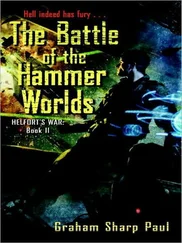Tom Avitabile - The Hammer of God
Здесь есть возможность читать онлайн «Tom Avitabile - The Hammer of God» весь текст электронной книги совершенно бесплатно (целиком полную версию без сокращений). В некоторых случаях можно слушать аудио, скачать через торрент в формате fb2 и присутствует краткое содержание. Жанр: Триллер, на английском языке. Описание произведения, (предисловие) а так же отзывы посетителей доступны на портале библиотеки ЛибКат.
- Название:The Hammer of God
- Автор:
- Жанр:
- Год:неизвестен
- ISBN:нет данных
- Рейтинг книги:3 / 5. Голосов: 1
-
Избранное:Добавить в избранное
- Отзывы:
-
Ваша оценка:
- 60
- 1
- 2
- 3
- 4
- 5
The Hammer of God: краткое содержание, описание и аннотация
Предлагаем к чтению аннотацию, описание, краткое содержание или предисловие (зависит от того, что написал сам автор книги «The Hammer of God»). Если вы не нашли необходимую информацию о книге — напишите в комментариях, мы постараемся отыскать её.
The Hammer of God — читать онлайн бесплатно полную книгу (весь текст) целиком
Ниже представлен текст книги, разбитый по страницам. Система сохранения места последней прочитанной страницы, позволяет с удобством читать онлайн бесплатно книгу «The Hammer of God», без необходимости каждый раз заново искать на чём Вы остановились. Поставьте закладку, и сможете в любой момент перейти на страницу, на которой закончили чтение.
Интервал:
Закладка:
Then he discovered “radio row” in lower Manhattan. It was in the old Port Authority Trans Hudson terminal, later shortened to PATH. Many old Jewish and Italian merchants who started to specialize in electronic junk had little stands and stalls there. They would buy/sell/trade their wares. It was the trade part, however, that enabled Peter to build his computer. He would find an old TV set in the lot that someone had thrown out. For a fifteen-cent token, he dragged the TV onto the IRT and schlepped the thing all the way downtown, then up the stairs and to the feet of one of the guys on Vesey Street. Often he’d walk away with a few 2N554 PNP power transistors or some 1N34 diodes. All precious gems in the collection that would become his DEMIAC 256.
A race with the clock started when he learned that all the old guys down on radio row — his friends Sol, Manny, Vinny, and Izzy — were on their last days. The entire Hudson Tubes Terminal was going to be knocked down to make way for some big old thing called the World’s Trading Center or something like that. Peter had to hurry to find, drag, and swap as many electronics carcasses as possible to have enough parts to finish his computer.
The seven scientists that Kasiko had gotten out of Hungary went on to find places to do their work. Some with governments, some with private industry. All in all, things were going well. Hardly a day went by that Dr. Brodenchy didn’t say a silent thank you for his luck. Many times, he thought of Kasiko and his surprise when they had reached Switzerland and Kasiko handed them back all the money he had taken minus the amount to bribe the officials and to feed them. Not a forint for himself. Just as often, he thought of his father and three sisters. They were all killed by the Russians. His father and two sisters were shot trying to “escape” to a mosque on a Friday. His other sister, Afifah, was raped then shot. If not for Kasiko leading them out of Hungary, he and his brother, all that were left, would have suffered a similar fate.
Dr. Brodenchy was thinking just this as he awaited a car to pick him up from the Idlewild Airfield in New York. He was on his way to a meeting at the United Nations. He had heard that Kasiko had settled in New York and if there was time, he intended to look him up.
Demiac 256 soon became a rare thing in the world. It was actually one of the first digital electronic computers not made by IBM, Honeywell, Control Data, or Burroughs, the big four computer mainframe makers of that day. Peter had taken the initial simple design and created a true operating environment by adding a tape drive utilizing sequential access. It involved a Craig portable reel-to-reel tape recorder, (thank you Mr. Cantor in apartment 3B) that he modified with a second “address” track. Added to that were some relays and stepping solenoids (thank you Mr. Catugno in 6A) from which he created an electro-mechanical operating system. He also added a card reader, which he built from other scrap parts and a wire scrub brush (thanks Mom, when you weren’t looking). Being influenced by James Bond movies and “The Man from U.N.C.L.E.” TV series, Peter built all his units inside attache cases (thank you Pat from Palumbo’s Music on Gunhill Road).
Once it was all hooked up and working, Peter took the CPU he built in the attache case with him and jumped on the downtown IRT. The outside of the case had a huge “1” in the computer-styled numbers of the day with the word PREMO underneath it. Each attache case that made up Demiac 256 had a huge number on the side of the case, like his favorite show, “Thunderbirds Are Go,” in “ marrionation, ” where each of the amazing vehicles the marionettes used to save the world each week had big numbers on them. The Premo was his signature contraction made from his first initial and his last name.
Peter planned to show the guys down on Vesey Street his project. But when he got there, the wrecker’s ball had started taking whacks and big chunks out of the Hudson Tubes terminal. Those guys, and an era, were gone. He started walking north, for what seemed like hours. Eventually, he found himself at Grand Central Station. From here, he could take the subway home. But he had another idea. The Union Carbide building was around the corner on Park Avenue. They were the company that sponsored the science fairs. Maybe a little advance publicity would be good for this, his mother of all science fair projects.
The lobby was daunting. It was so huge. The elevators only went to certain floors and a directory took up an entire wall. He scanned it and his eyes locked on “Computer Dept. NYRCC. 47th floor.”
He found the 35–50 bank of elevators and got on. The only elevator he had ever been on was the one in his cousin’s house in the “projects” that moved slow but still beat walking up the six floors of the subsidized housing complex. His stomach reacted as if he were on the Dragoncoaster at Rye Beach Playland as the elevator sped straight up. It was his first time in a Manhattan skyscraper. When the doors opened, he walked around a little and then saw a door that said, “Authorized Personnel Only.” So, of course, he walked right in.
He walked up an incline to a raised floor. There were computers humming, buzzing, and blinking everywhere. Dozens of big red tape drives and big rectangular cabinets with flashing lights and colored knobs crammed the entire 50th floor. Inside this computer room, the air was crisp and cold. It smelled sharp and acrid. There was the whirring and an occasional swooshing sound as tape drives rewound and their power windows opened. He was taking all this in when a hand came down on his shoulder.
“How did you get in here?”
Peter looked up and saw the scowling face and grim demeanor of a man in a blue shirt and yellow tie.
“You can’t be here, kid. I’ll walk you out.”
Thinking quick, Peter said, “Er… I built a computer.”
“That’s nice, son. Aren’t you supposed to be in school?”
“No, really. I have it right here in this case.”
That stopped the man. “Show me.”
“Can I put this down over there?” Peter pointed to a return table off the CPU of the IBM mainframe that was currently one of the twenty computers operating at Union Carbide’s New York Regional Computing Center. The man who collared him, Ed Cortez, was a director. Peter plopped down the attache case and popped the latches. As he opened it, he saw Mr. Cortez’ eyes widen and jaw drop. Whose wouldn’t? There before him in a nineteen-inch wide by eleven-inch deep attache was an impressive array of light bulbs, switches, red-and-black binding posts, jeweled power lights, and a big telephone dial. Peter hit the power button and then the reset button. The light bulbs, which were randomly lit across two rows, all reset to the lower row. He then dialed a ten, and as the dial turned, the lights jumped and flashed in a special order that only a computer scientist would recognize. The number he dialed in was transformed into on-off-on-off, or the number “10” in binary code.
Peter further ingratiated himself to Mr. Cortez by pointing out that the bank of register lights in the attache case — 1,2,4,8,16,32,64,128 — was the same as the register monitor on the IBM SYSTEMS 360 — 65 CPU main panel. In short, he just equated his thirty-five dollar science project with the six-million dollar machine that was one of the biggest operating anywhere in the world.
Soon, many C.E.s, programmers, and operators were gathered around the pimply-faced kid with the suitcase computer. So much so, that in time the big blue machine went unattended and that brought out Ed Ryan, Chief of NYRCC. Although Ryan started out hard-assed, soon the little kid and his science project had the same “Gee Whiz” effect on him. To many of these computer engineers — among America’s business computing elite — this was the son they wish they had. And like good stepfathers, they showered him with gifts. Manuals, schematics, power supplies, and coveted circuit boards — with the gold contacts still on them! Sol and the boys at Vesey Street would have given him the whole store for one of these, just for the gold. This new paternal group offered him a summer job, but more than he could ever imagine was about to come.
Читать дальшеИнтервал:
Закладка:
Похожие книги на «The Hammer of God»
Представляем Вашему вниманию похожие книги на «The Hammer of God» списком для выбора. Мы отобрали схожую по названию и смыслу литературу в надежде предоставить читателям больше вариантов отыскать новые, интересные, ещё непрочитанные произведения.
Обсуждение, отзывы о книге «The Hammer of God» и просто собственные мнения читателей. Оставьте ваши комментарии, напишите, что Вы думаете о произведении, его смысле или главных героях. Укажите что конкретно понравилось, а что нет, и почему Вы так считаете.












